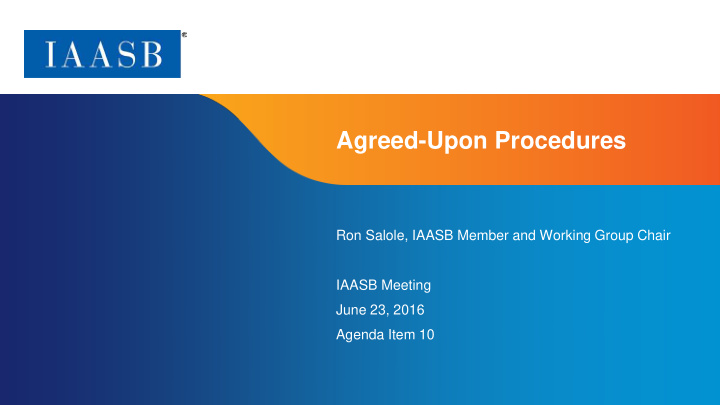



Agreed-Upon Procedures Ron Salole, IAASB Member and Working Group Chair IAASB Meeting June 23, 2016 Agenda Item 10 Page 1
What We Hope to Achieve at This Session Obtaining the views of the Board on the content and clarity of the Working Group Discussion Paper , Exploring the Growing Demand for Agreed- Upon Procedures Engagements and Other Services and Implications for the IAASB’s Standards Page 2
What We Hope to Achieve at This Session Para. 15-57 Para. 65 • Overview of • Multi-scope Discussion Engagements • Agreed-Upon • What Paper Procedures Happens Next • Introduction Engagements Para. 1-14 Para. 58-64 Overall Comments? Page 3
Overview of Discussion Paper and Introduction Purposes of Discussion Paper (Para. 1-2) What are Agreed-Upon Procedures (Page 2) Introduction (Para. 3-14) • Who Uses an AUP Report? Why are AUP Engagements Performed and What are their Benefits? • Why is the IAASB Undertaking Work on AUP Engagements? • What Has Been Discussed by the IAASB and Its Consultative Advisory Group? Comments? Page 4
AUP Engagements Background and Issues (Para. 15-19) •The use of professional judgment in an AUP engagement •Professional skepticism •The use of ambiguous terminology in describing procedures or findings •AUP report restrictions •The format of the AUP report •Performing AUP engagements on non-financial information •Using the work of others •Users who are not parties to the engagement agreement •Recommendations in conjunction with AUP engagements •The role of independence in AUP engagements Comments? Do you agree with the issues identified? Are there any other issues that should be explored? Page 5
AUP Engagements The use of professional judgment in an AUP engagement (Para. 20-25) • Professional judgment on decisions about engagement acceptance, planning, parties to the agreement, and documentation • Professional judgment exercised in the context of professional competence and due care Professional skepticism (Para. 26) • Issue explored as part of the IAASB’s Enhancing Audit Quality initiative • Not seeking input at this time Comments? Page 6
AUP Engagements The use of ambiguous terminology in describing procedures or findings (Para. 27-33) • Ambiguous terms: Terms given technical meanings in standards that differ from their normal English meaning or are otherwise not sufficiently specific • Prohibit the use of ambiguous wording unless the wording is required by regulations or contracts AUP report restrictions (Para. 34-37) • Restrict the use (but not the distribution) of the AUP report Comments? Page 7
AUP Engagements The format of the AUP report (Para. 38-39) • Illustrative report that presents: • The procedures and corresponding findings in a tabular format; or • Each procedure and corresponding finding together. Performing AUP engagements on non-financial information (Para. 40-42) • Broaden scope to include AUP on non-financial information • Pre-acceptance considerations on practitioner and engagement team competence Comments? Page 8
AUP Engagements Using the work of others (Para. 43-44) • When using the work of others, the practitioner should be required to evaluate: • The objectivity and technical competence of the other parties; and • The procedures performed and factual findings reported by the other parties. Users who are not parties to the engagement (Para. 45-49) • If the Terms of Reference is available – the practitioner should be able to determine that the user has a clear understanding of the AUP engagement even though the user is not a party to the engagement agreement • In the absence of Terms of Reference – the practitioner may consider obtaining affirmative acknowledgement that the user and other relevant parties agree to the procedures to be performed and take responsibility for the procedures Comments? Page 9
AUP Engagements Recommendations in conjunction with AUP engagements (Para. 50-51) • Recommendations in conjunction with an AUP engagement = A multi-scope engagement consisting of an AUP engagement and a separate service • Communications arising from such additional services should be clearly distinguished from the AUP engagement and report The role of independence in AUP engagements (Para. 52-57) • Require the lack of independence to be disclosed in the AUP report (i.e., current approach under ISRS 4400) Comments? Page 10
Multi-scope Engagements and Next Steps Multi-scope engagements (Para. 58-64) • Multi-scope engagement – An engagement that comprises of 2 or more separate services within the IAASB pronouncements • Multi-scope engagements should be separated from the project to revise ISRS 4400 as the scope extends beyond ISRS 4400 What happens next (Para. 65) • Project proposal to be developed taking into account input from stakeholders on the Discussion Paper and the IAASB’s 2017-2018 Work Plan Comments? Page 11
www.iaasb.org
Recommend
More recommend